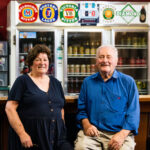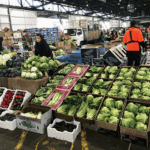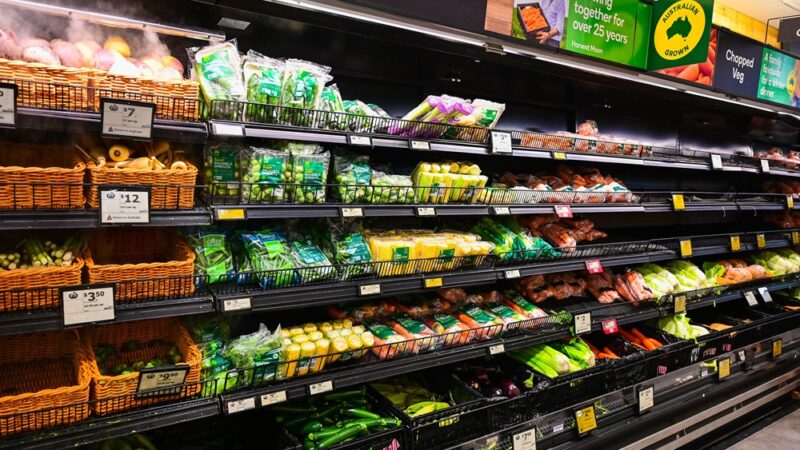The pastoral town of Ivanhoe was headed for a deep slumber in 2020 after a…
Flesh in the game: the annual cattle report
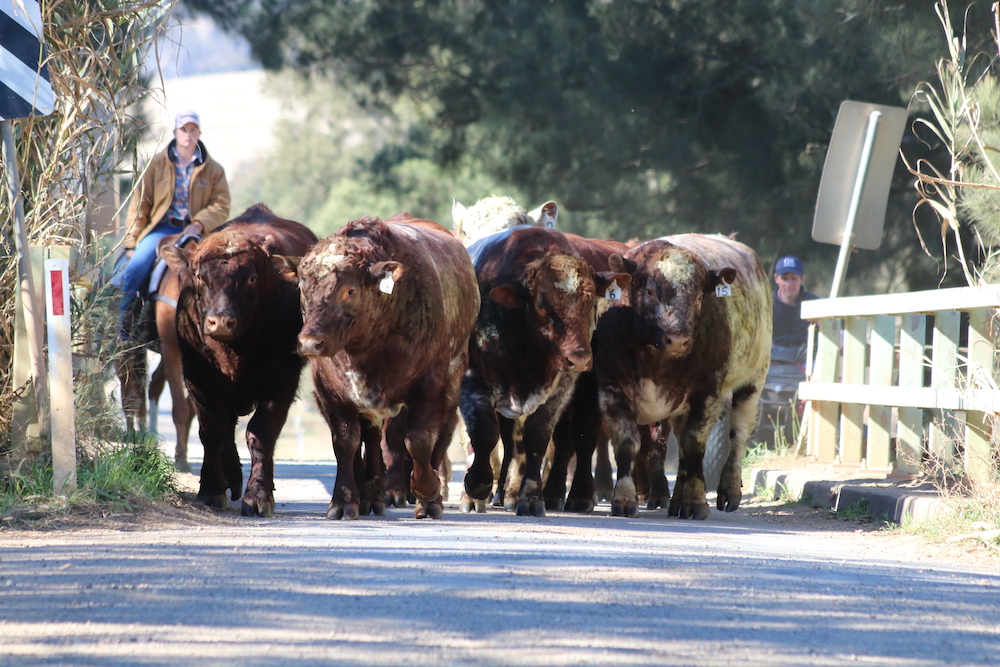
The cattle report showed that the outlook is so positive that Meat and Livestock Australia is forecasting 5.6 per cent growth this year in national herd building, to 27.6 million head.
The top five markets for export of Australian beef continue to be China, Japan, Korea, Vietnam and the United States of America, particularly for quality grass-fed and grain-finished beef. China also takes commodity beef from Australia.
This demand reflects a growing middle class in all of the top five countries, with increased earning capacity matched by an increased demand for quality protein in the form of meat, particularly red meat.
An increasing demand for heavier cattle has seen MLA estimate 2022 slaughter rates will be lower than initially predicted � as it originally forecasted numbers to rise by 11 per cent this year. But overall beef production is forecast to rise by 4.5 per cent to 1.97 million tonnes.
Continued good seasonal conditions in farming country � notwithstanding six months of rain across the eastern seaboard and flooding in March affecting many cattle regions in NSW � has guaranteed full soil moisture profiles, giving farmers confidence in spring pasture growth.
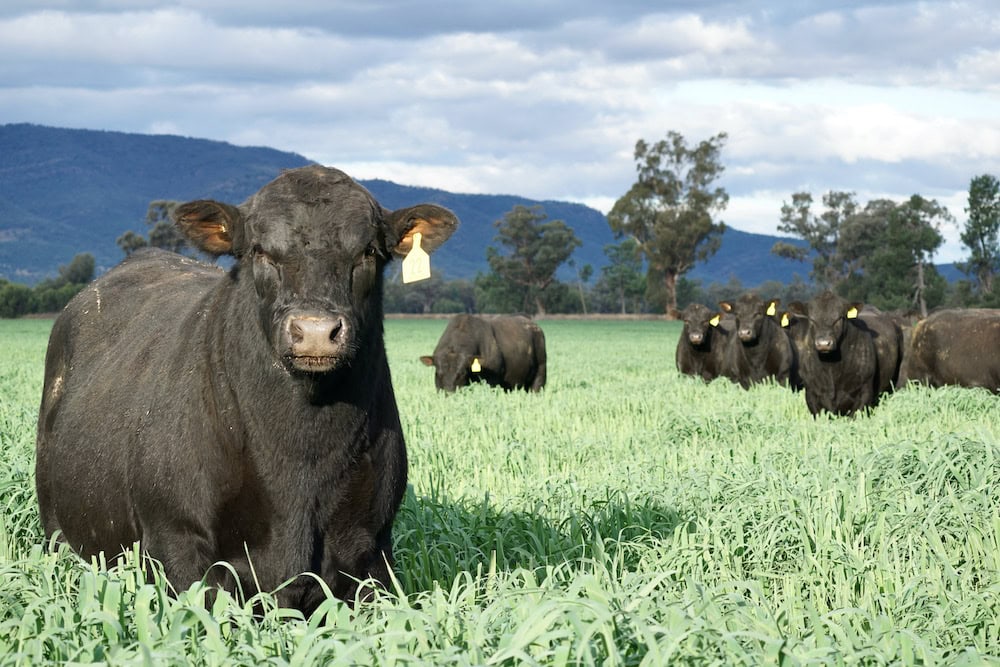
The continued growth in demand for Australian beef as a quality grocery item is a significant reflection back on Australia�s main competitive markets, which are in a state of decline and are filling the demand for ground and trim beef, in a similar way to how we were during the protracted drought. These markets include domestic supply in the USA, and Argentina and Brazil, countries that are all in herd retraction status and, like Australia, among the top seven global producers of beef.
Now the Bureau of Meteorology is forecasting potentially successive La Ni�a rainfall and other weather predictions also support ongoing positive rainfall conditions. So long as favourable weather and climate conditions continue, herd expansion will be maintained.
In recent years, some producers have coupled their herd expansion with an integrated supply chain, developing their own feedlot and processor facilities. There has also been growth in paddock to plate agribusinesses, either as single origin beef or with regional branding encompassing a number of breeders.
This has all added up to steadily rising prices at the farm gate in the cattle industry. Commentators keep talking about their expectations that prices will plateau and reset, but the demand for beef globally, especially quality beef, continues to drive cattle prices in Australia.
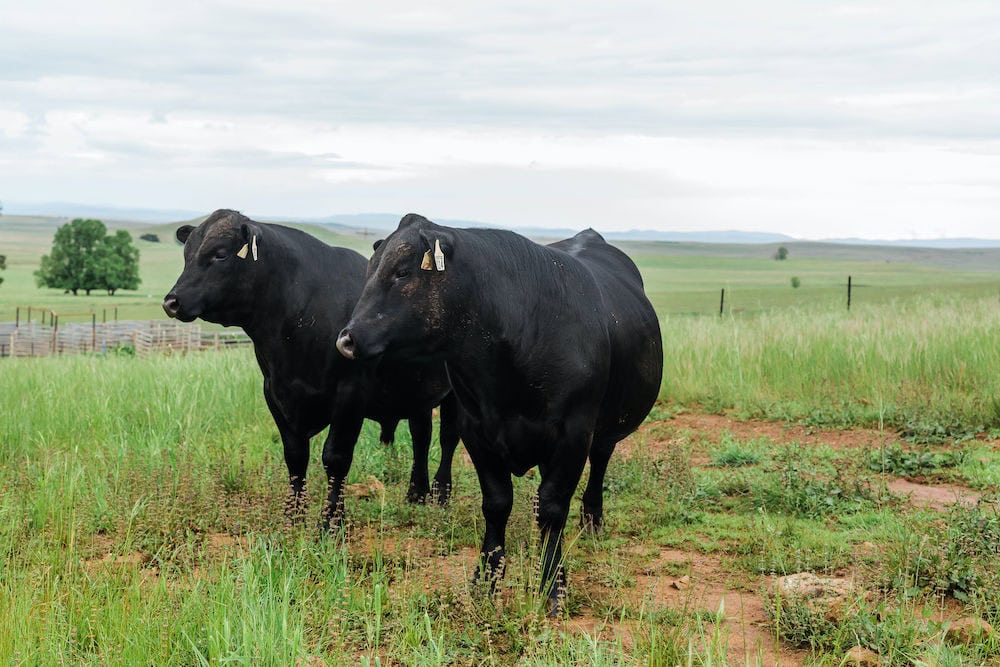
Where did this demand come from? It�s not an overnight sensation. It�s a reflection of decades of breeding investment by cattle producers, and lobbying by producers and industry groups to leverage overseas markets.
It�s about building animal welfare and safe food handling into Australia�s supply chain.
It�s about culling poor quality cattle and building a herd that is genetically fertile and produces cattle that lay down muscle and marbling in a steady growth pattern.
It�s about building a national herd that can finish on grass or grain, allowing Australians to fill diverse markets without having to make major adjustments in their breeding goals.
And it�s about investing in and improving the knowledge and skills of everyone who works along the supply chain.
Bulls selected for performance
Last year, reflecting beef producers� confidence, cattle breeders purchased 10,000 bulls at auction, as the herd rebuild that began in the previous year gathered pace.
Dependent on seasonal conditions and no major climate nor biosecurity disasters, MLA forecasts for the next couple of years large numbers of cattle on feed and prices remaining high. Premiums are incentivising breeders and backgrounders to increase the weight of cattle before they enter the feedlot.
This year, as part of their open day inspections, the Laurie family of Knowla Livestock organised a series of guest speakers and created a knowledge-sharing event. One of the speakers who addressed the 100-plus-strong crowd of attendees, explained how to prepare cattle for a feedlot.
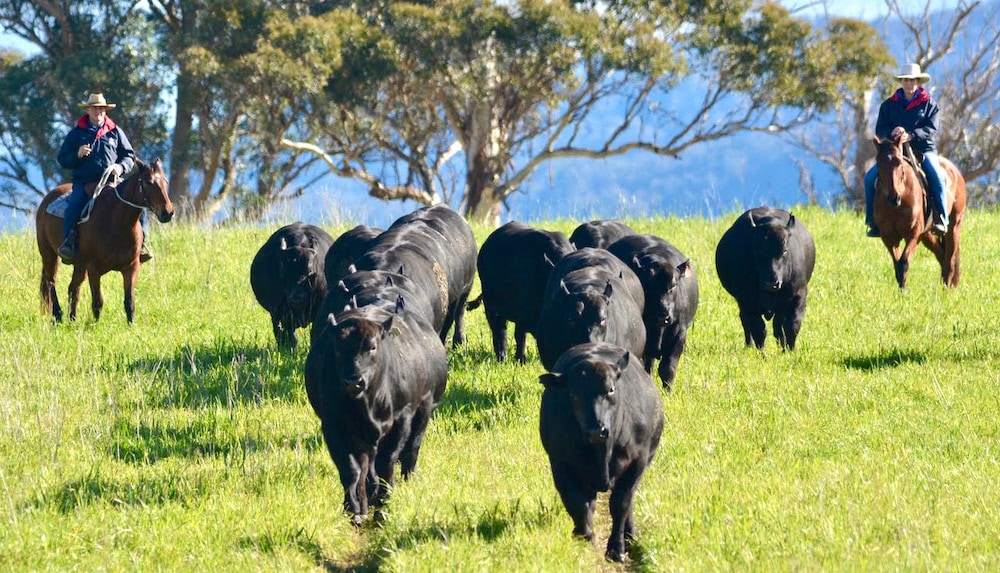
�We thought this year we�d put on a bit more than a pre-sale inspection day, so we organised a genetics industry day and well over 100 people attended,� Ted Laurie said.
Andrew Talbot from Elders Killara feedlot talked about feedlot inductions and the pathway that producers can take in preparing their cattle on farm to go into the feedlot.
�We thought it would be valuable knowledge for us and our clients,� Ted says. �Most of our clients are within a 250km radius of our property and a lot of them sell their turnoff as weaners or as feeder steers in the Angus feedlot market.�
The information segued well with a discussion about Knowla stud genetics, presented by Jack Laurie, with an emphasis on how steers from the family�s own commercial herd performed in the feedlot system.
�It definitely helps shape what we�re doing from a breeding perspective We sell our commercial progeny into the feeder steers market.�
Ted Laurie from Knowla Livestock
The Angus effect
It�s no surprise, either, that a feedlot would specialise in finishing Angus cattle, given 48 per cent of Australia�s national herd is Angus or has components of Angus breeding.
That percentage is not lost on the Litchfield family, principals of Hazeldean Angus. Two generations of the family � Jim and Libby, with daughter Bea and her husband, Ed Bradley, breed stud and commercial herds in Cooma, and run four bull sales, two on-property at Cooma, one in Tamworth and one in Queensland.
The demand for British breeds to bring muscle development into northern cattle, enabling producers to turn off young stock faster into feeder steer markets, has seen the rise of Angus-cross progeny in northern Australia, and in northern NSW, including the development of Brangus � a cross of 5/8 Angus and 3/8 Brahman � as a breed of its own.
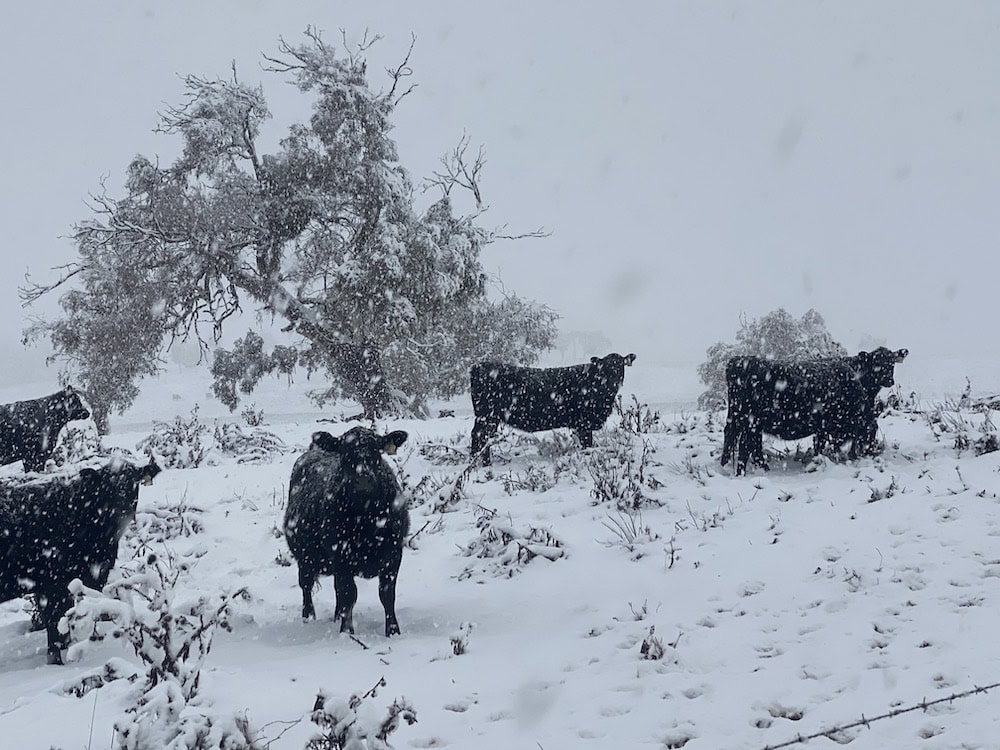
For 25 years, the Litchfield family has been selling Angus bulls to Queensland pastoralists. All bulls are bred at Cooma, in NSW Monaro country, renowned for its short growing season and tough snow-filled winters.
�We breed our cattle in the south at Cooma, as they often need to calve and rebreed before a Spring break,” says Bea Litchfield.
�When they go into more marginal country in Queensland, the bulls perform. A lot of our Queensland clients have cross-breeding enterprises and buy Angus for ease of calving, improved carcase merit and significant market premiums.”
Bea Litchfield from Hazeldean Angus.
�Our southern clients want a complete package of calving ease and getting growth into the calf. There�s a lot more focus on carcase quality, particularly intramuscular fat, and breeding cattle that producers and processors know are going to perform well on the feedlot grids.�
Bea said having a reputation for breeding bulls with superior fertility and growth and constitution traits was an advantage, as commercial breeders were looking for potential sires that could equally go into mobs of heifers and cows.
�The cattle industry forecast is for a very, very positive future. The market is sitting in a place that complements people�s breeding,� she says.
�The demand for red meat is continuing to head in a positive direction, locally and globally,� she adds. �For those cattle producers who stuck it out through the drought and kept the best of their herds, they�ve been able to invest in more bulls and increased their joining rates. So long as there�s grass on the ground, there�s buoyancy. When that tightens up, we�ll see an adjustment in the market.�
Building knowledge across the industry
With the next generation coming into the cattle industry during a buoyant period, the emphasis is on opportunity and knowledge building. A healthy industry expands that knowledge building across the sector, focussing internally and externally, formally and informally.
Studs such as Knowla Livestock support knowledge development through partnerships with schools. About a decade ago, on their daughter�s initiative, Ted and Alison Laurie helped Pymble Ladies College establish a cattle club, and they continue to donate four steers each year.
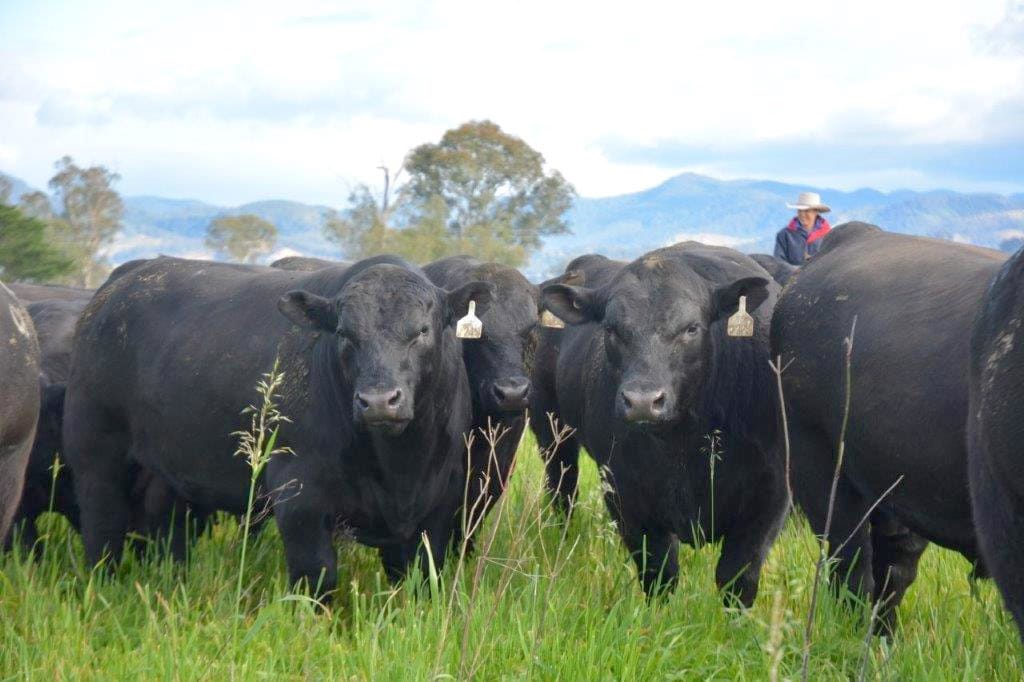
�The students have had great success showing our steers and entering a carcase competition every year,� Ted Laurie says.
�It�s a really good partnership. Forty students participate in two classes a week, learning to look after and feed the steers, and they show their cattle in a few local shows throughout the year. It�s also an opportunity to educate students from suburbia about the beef industry, about where their food comes from and how it�s produced.�
The cattle are part of a small school farm that also hosts sheep, chickens and ducks.
At Booragul Angus stud, the Vincent family continues to support the next generation, with Hayden undertaking a certificate in agriculture traineeship on farm, working beside his parents, Tim and Margaret. Hayden is the third generation of the family to be involved with Booragul Angus, where the focus is on own-bred bulls, and the buying of selected genetics.
�We select up to six bulls a year that we�ve bred ourselves, to use in our breeding program,� Tim says.
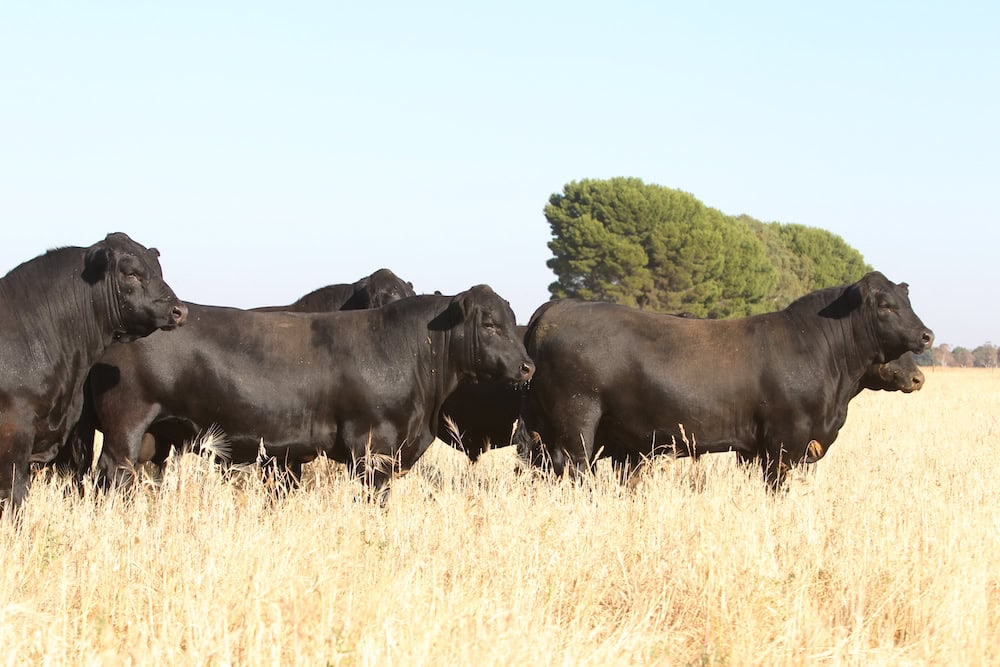
The strategy pays off. Last year, the highest price paid for a bull at their on-property sale was for a son of Booragul Docklands. He had progeny on the ground prior to the sale, which enabled clients to see the physical results of breeding by him, as well as his genetic data.
Tim has been a mentor for many years, and is on the Northern Advisory Committee, working with commercial cattle breeders in northern Australia.
�The members of the Northern Advisory Committee are working with commercial cattle breeders in northern Australia to identify how to breed with Angus in the tropical climate and achieve profit margins.�
Tim Vincent of Booragul Angus.
More broadly, industry initiatives can create measurable benefits where they�re least expected. At the end of June this year, Angus Australia released a range of education and training resources for livestock agents, to help them build the skills needed to help their clients build their businesses.
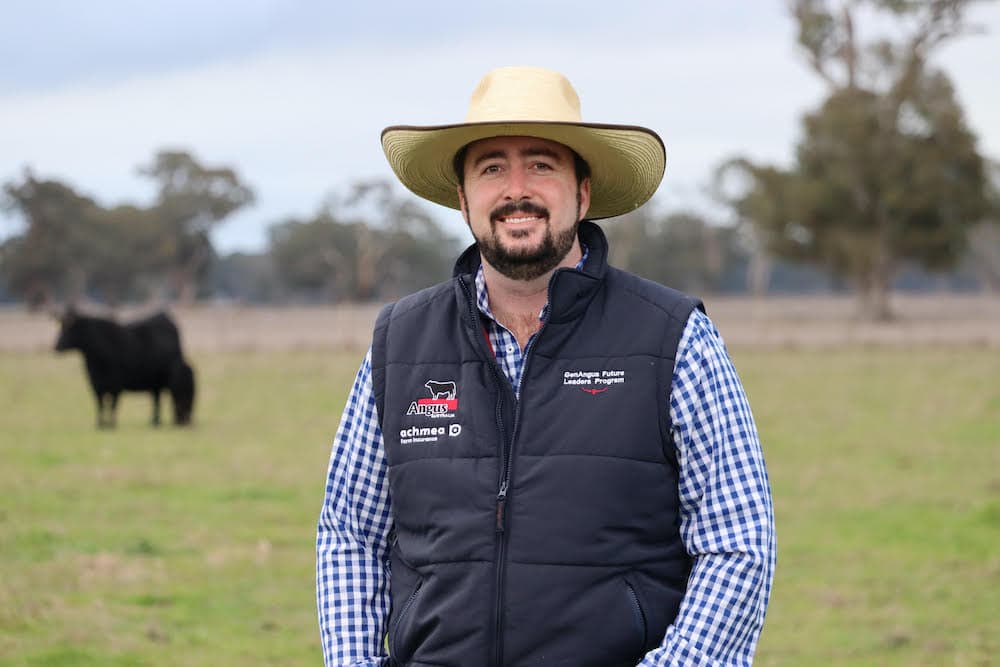
Jake Phillips, Angus Australia�s Extension Manager, said The Stock Agent�s Toolkit is a new addition to a suite of resources in the organisation�s online Education Centre and recognises the livestock agent�s role in the beef industry.
�We realised livestock agents play a really crucial role for being a catalyst of stud and commercial information, so we created an education tool that�s very tailored for stock agents, with written, video and audio options.�
Jake Phillips, Angus Australia�s Extension Manager.
�It summarises a lot of information available to breeders into key segments, including about the role of genetics in a clients� herd, environmental factors, and how to interpret information in sale catalogues.
�Stock agents are the catalyst for the transaction that occurs in the marketplace between the seedstock breeder and the commercial buyer. This toolkit will enable them to have strategic conversations about genetics with breeders and clients.�
Expanding the industry
The Laurie family are one of a number of studs that release female cattle each year � from their stud and commercial herds � to enable people to enter the industry, or expand their existing herd�s genetic potential.
This year Knowla Livestock will again offer six pregnancy-tested-in-calf stud heifers and 100 unjoined commercial heifers, as part of their on-property bull sale, at Kangangra.
�People breed their own females, so we focus on the maternal traits, and we don�t compromise on things like temperament and the maternal traits of cows,� Ted says.
�We create a moderate package that fits most production systems.�
For the second year in a row, Knowla Livestock will also support NSW Farmers members who buy at their bull and female sale. Financial NSW Farmers members, who register as bidders at the production sale, will receive a one-off $500 rebate on their purchase at the sale.�
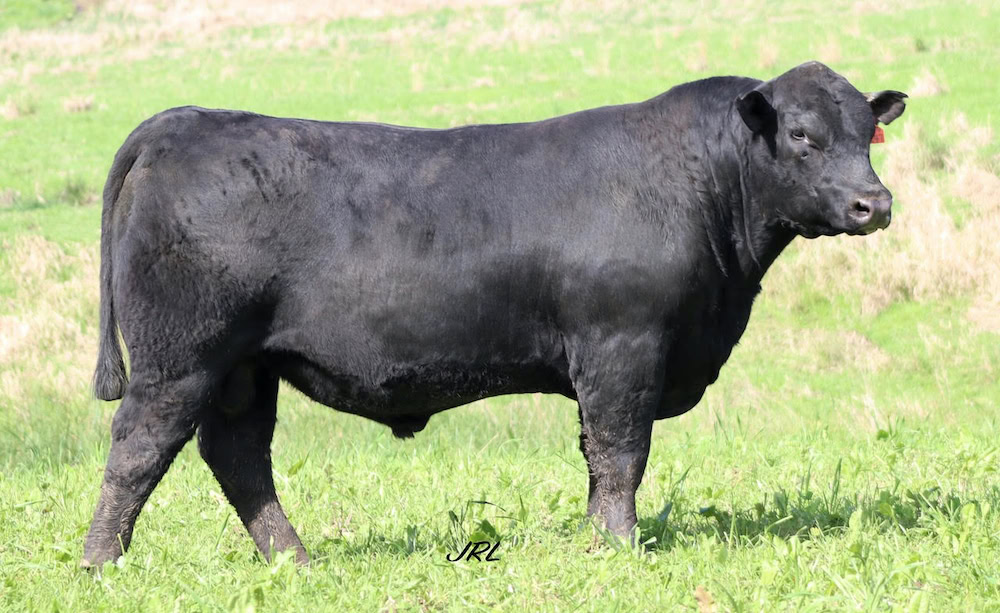
�This was a popular offer at last year�s sale, so we�ve decided to continue it this year,� Ted says. �We feel NSW Farmers Association does a very good job of representing NSW farmers and we also want to show our appreciation to existing clients for their support of the organisation and our sale.��
Circle 8 principal, Jeremy Cooper, has decided to celebrate 30 years of breeding by releasing an entire quotient of heifers at this year�s on-property bull sale.
At Booragul Angus, the Vincent family released embryos for sale this year, bought by studs in Victoria and Queensland at the Sydney Royal Show at Easter. The embryo sale was a follow up to their first female sale in November last year.
�The female sale was an opportunity to attract new clients and provide an opportunity for younger people coming into the industry to invest in some prime genetics,� Tim Vincent says.
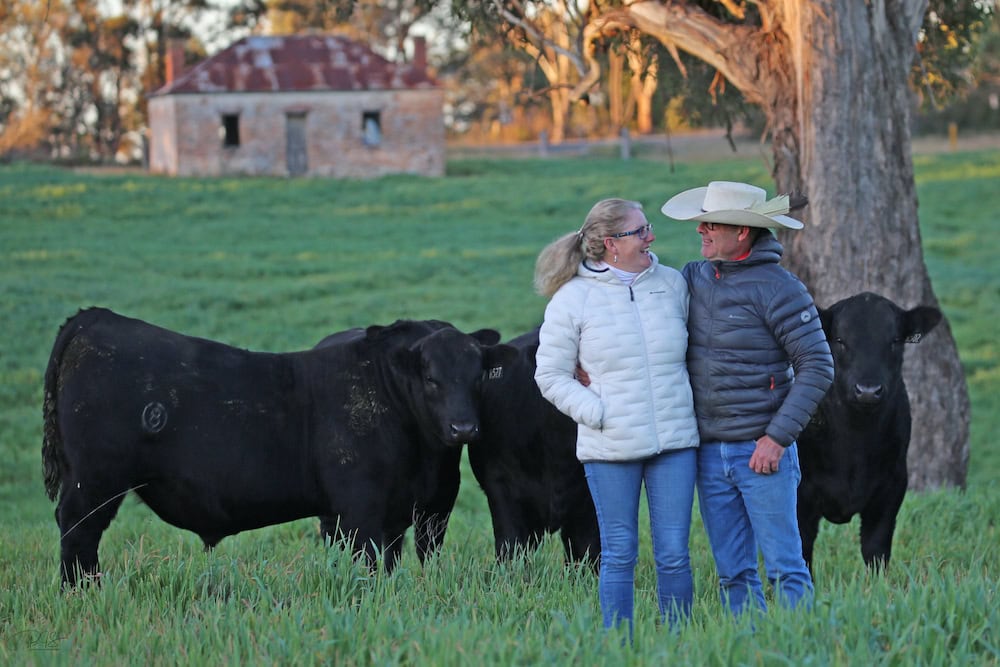
Booragul Angus bulls are bred for diverse markets, bought by breeders from northern NSW, Katherine and South Australia.
�We have to supply bulls that have a pretty broad range of requirements � for breeders, to sire progeny that meet the heavy steer feedlot grid, to breed terminal cross cattle in northern Australia where they end up in a composite, and for commercial
breeders in New England and northwest NSW that are meeting supermarket specifications,� Tim says.
At Ironbark Herefords, Adrian Spencer has taken advantage of opportunities to be an advocate for the cattle industry, travelling to the northern hemisphere to help build Australia�s live cattle trade markets. Taking those opportunities helped him build partnerships to sell breeding females into Serbian and surrounding countries, building the global uptake of Australian genetics that has helped establish new markets.
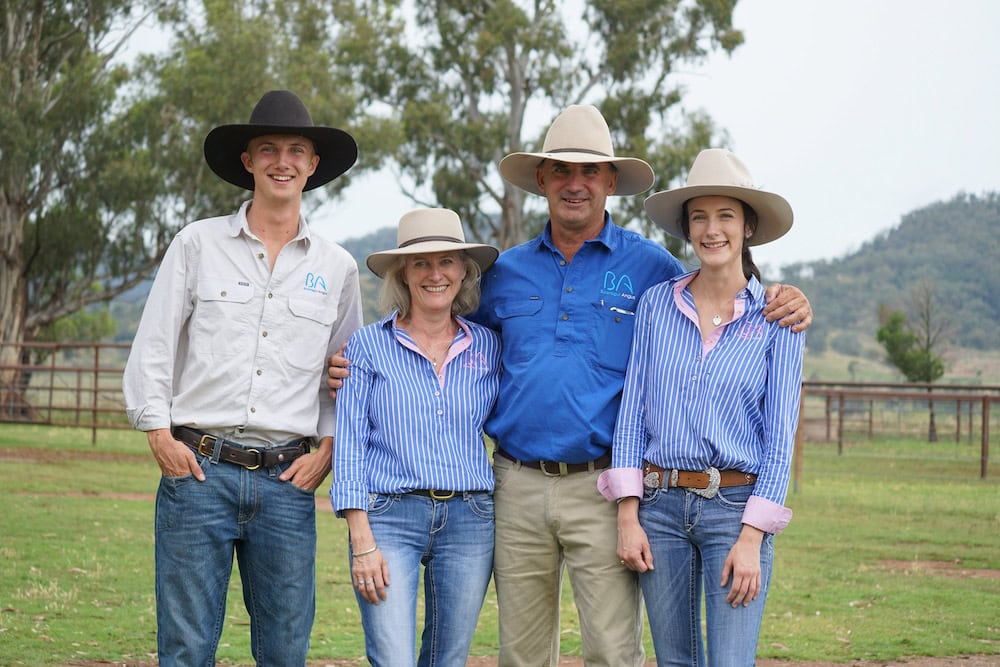
Bulls help build beef branding
The modern day customer is searching for more than just beef when it comes to their consumer habits � they are looking for a quality eating experience and, from a beef industry point of view, it is important that we give them that.
That�s the view of Turanville Shorthorns principals, Doug and Nic Robertson.
With the Meat Standards Australia (MSA) grading system now widely adopted across the beef industry production chain, processors can underpin quality in their production systems and in doing so grow brand names.
�Building quality is where the future of the cattle industry lays,� says Doug.
�For a branded product to survive in the marketplace it must be of high quality and consistent and these characteristics are both delivered by Shorthorns. This is also why they still walk the paddocks of Turanville and have done so since the mid-1800s.�
Doug Robertson of Turanville Shorthorns.
Doug, as the current generational custodian of Turanville, has spent his life developing the herd. �I focus on mid maturity style cattle that are balanced in their carcass attributes. Above average marbling is a must, along with doing ability and fat cover. Visual muscle shape with a good soft cover results in yield � we have to maintain yield for processor profitability as well,� he says.
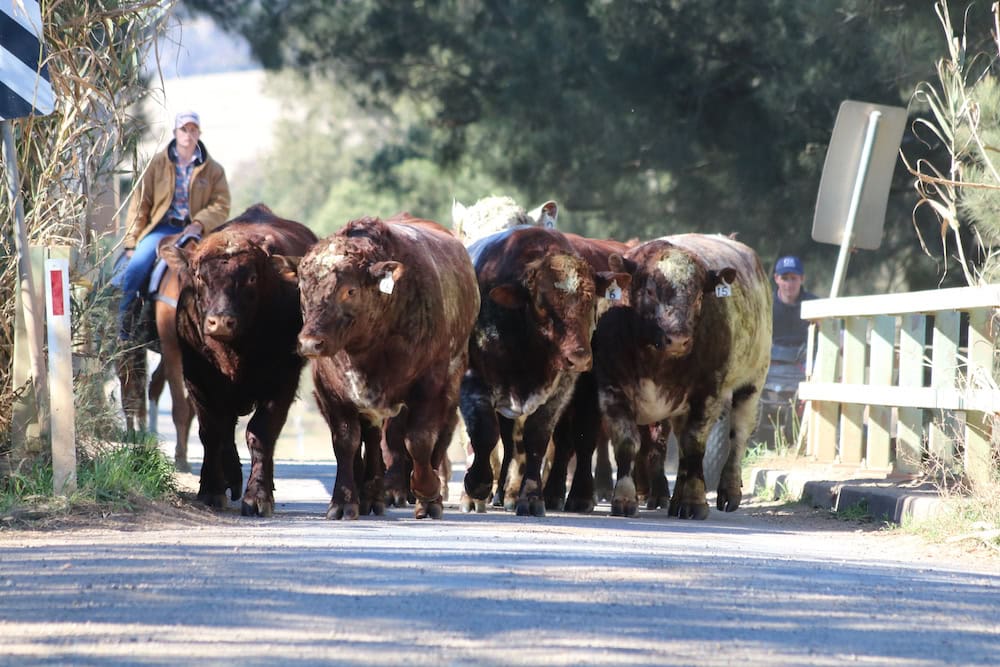
�This leads me to source genetics that have shape and muscling, but are not too heavy in the bone, so as not to create calving problems.�
Many Turanville clients produce feeder steers for the Thousand Guineas brand label and since its inception the brand has continued to build returns for producers, with feeder steer prices consistently competitive and profitable for the producers who supply to it.
�On occasions, Turanville Shorthorns genetics have achieved above the Angus feeder price,� Doug says. �As well as the Thousand Guineas Grid, Shorthorns also fit well into the JBS Great Southern Grassfed label. Turanville has focussed on this market with their own commercial cattle and has also seen clients achieve some outstanding results.
�Rose Grange Pastoral Company, with properties in Victoria and southern NSW, joins Turanville Shorthorn bulls to Angus cows. They recently consigned a line of 54 steers to the JBS Great Southern Brooklyn plant.
�From a profitability point of view, the most telling fact from the kill sheet data shows 30 per cent of the consignment achieved the 0.30c/kg premium for high indexing, high marbled carcasses.
�These results back up our claims of carcass consistency by using Turanville Shorthorns. Across the kill sheet the average weight of the steers was 390kg with an average ossification of 152. The average marble score was 3.52 with one individual scoring a 9.
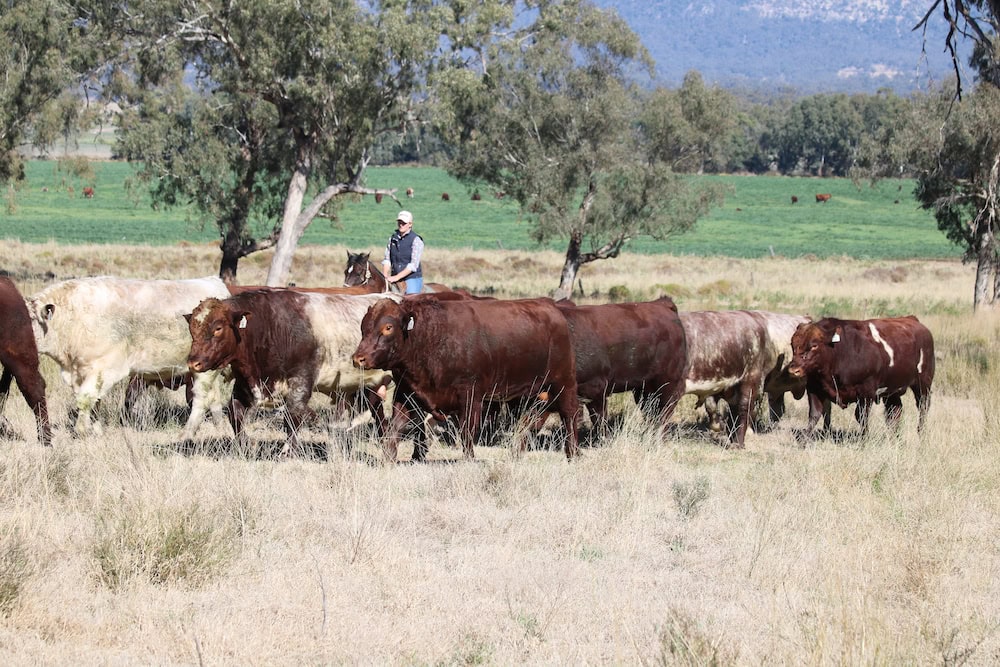
�What�s very favourable is this was done with average fat measurement of 11mm, which reflects good yield results for the processor. The consignment had an average MSA Index score of 64.93 across the 54 head of Shorthorn-Angus cross steers.�
Doug said the results reflected a genetic mix that balances carcasse traits with maternal and fertility traits.
�These are the real drivers of profitability in a commercial herd and are the traits we believe Turanville Shorthorns can really deliver on,� he says.
In the last four years Doug and Nic have brought an infusion of Red Angus genetics into their breeding program; this has created their Durham Red breeding program.
�The Durham Reds offer clients the opportunity to introduce hybrid vigour into their own herds without compromising their Shorthorn traits and, more importantly, Shorthorn branded markets like Thousand Guineas, which requires cattle with assured 75 per cent Shorthorn blood,� Doug says.
�The Red Angus genetics have to pass rigorous standards to be included in the Durham Red programme at Turanville and the future of these cattle was cemented by the inquiry at last year�s sale when the first Durham Red was offered.�
Doug Robertson of Turanville Shorthorns.
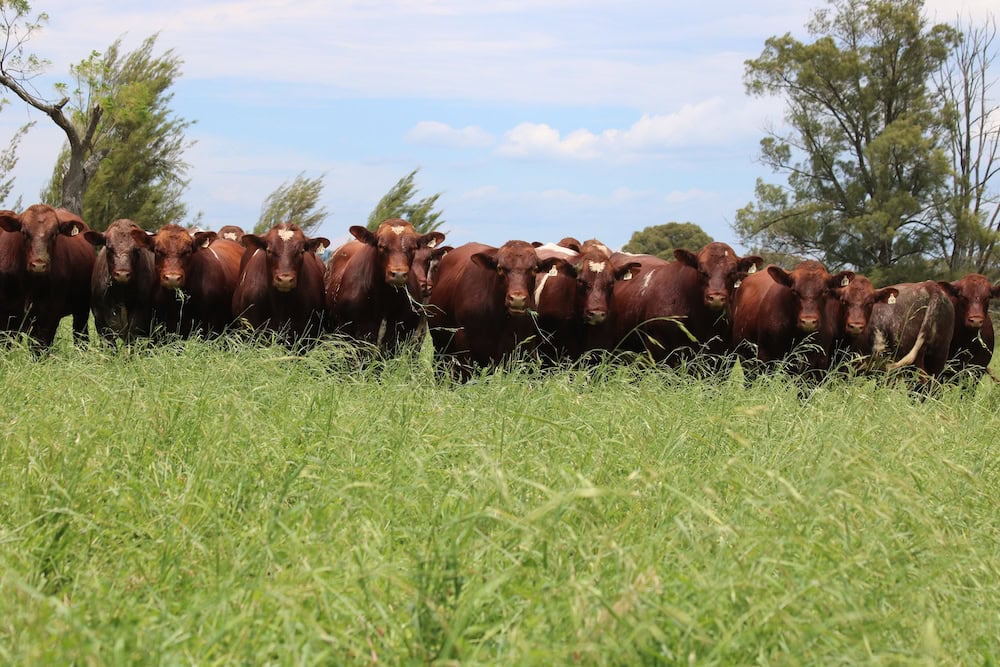
More stud breeders are proving the capacity of Australian cattle by following the performance of their own and their client�s commercial progeny. The family behind Hazeldean Angus is also focussed on extrapolating data that helps their clients run profitable businesses.
�Almost all our customers are commercial breeders, we rarely sell to stud buyers,� Bea Litchfield says. �Because of our scale, we focus on commercial viability.�
The family has commercial and stud herds on their Monaro properties and Bea says this is an advantage when it comes to understanding clients� businesses.
�If your commercial herd is performing for you, it�s a direct result of what you�re doing in the stud herd. It�s in synch with what your clients are doing, trying to run a profitable operation,� she says.
Hazeldean Angus turns off weaner cattle, trading directly with Rangers Valley Feedlot, reflecting the same business decisions of many of their clients.
�Our clients are using Angus genetics in straight and cross-bred breeding systems, in southern and northern climates, needing cattle with good constitutions that can withstand and perform in a wide range of environments,” Bea says.
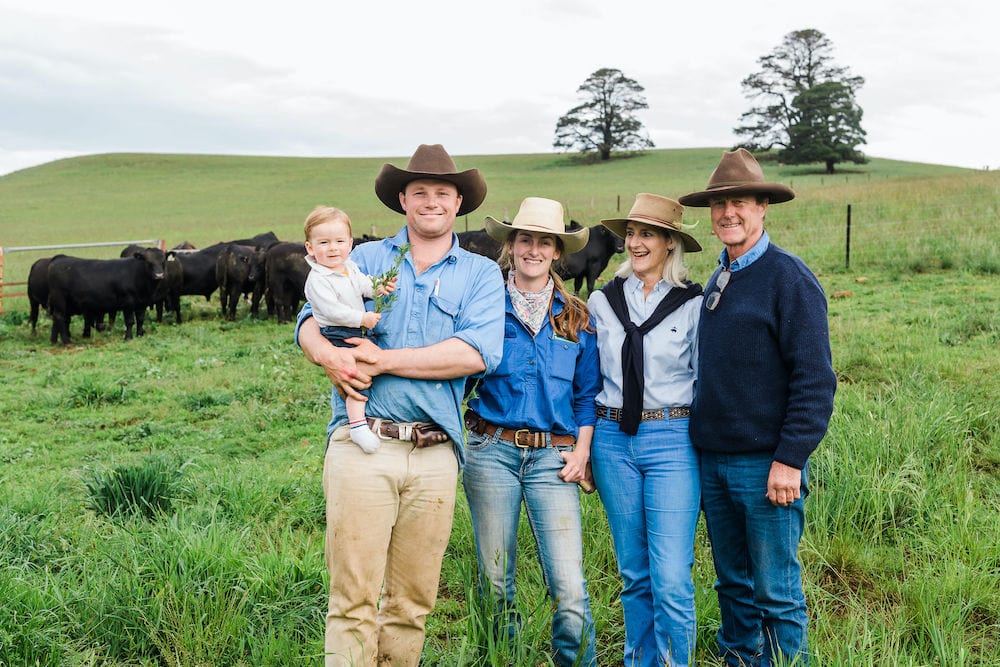
�By understanding what our commercial cattle are doing � and knowing we are doing it in a no-frills system that is all about structural correctness, temperament and commercial viability � how our cattle perform in a feedlot environment reflects knowledge about how our clients� cattle perform.�
Creating strong partnerships
The family behind Ironbark Herefords has a multi-faceted branded business building real rewards for clients, tracing data from the bull pen to the feedlot.
Adrian and Wendy Spencer � with children Hugh, Ben, and Isabella � run stud and commercial breeding herds and a feedlot to grow out and finish their own and clients� cattle, consistently meeting the grid for a local beef processor.
Adrian and Wendy focus on their breeding herds � with 1000 stud cows and 300 commercial cows � while Isy, Ben and Hugh are responsible for the feedlot with its focus on turning off 400 cattle each month for a domestic processor. The family is supported by a staff of seven people.
�Everyone has roles across the enterprise,� Adrian says.
Ironbark Herefords provides their own and some clients� feeder cattle for a 70-day turnaround, going in at 340-350kg and killed at a dressed weight of 270-310kg. They also purchase 2000 trade steers throughout the year for the feedlot.
The data from the feedlot and processor helps shape the family�s own stud and commercial breeding direction.
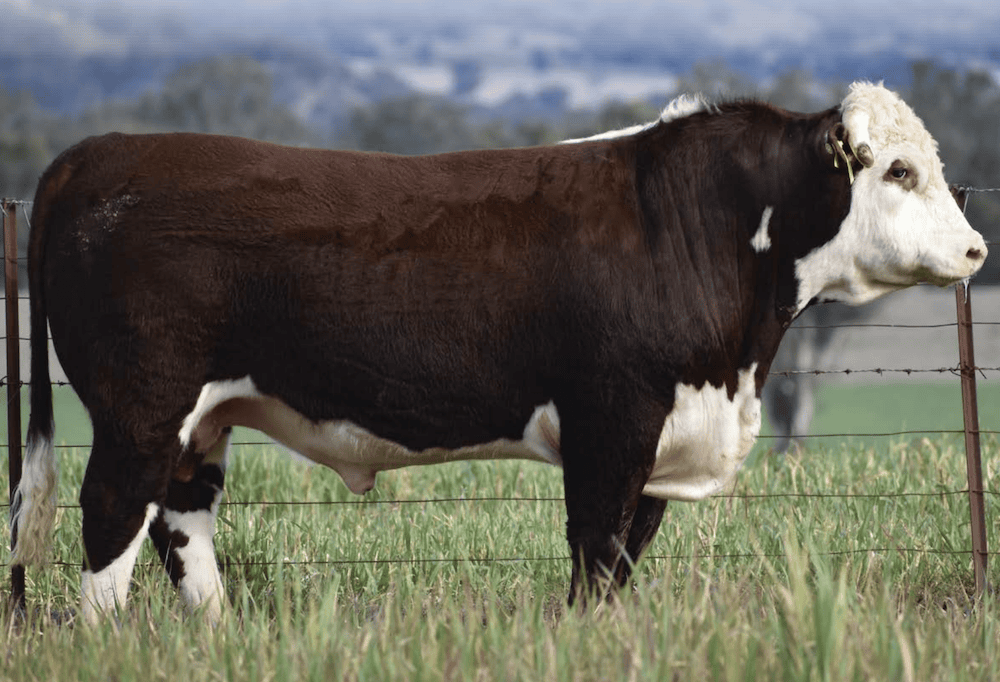
�We get a lot of feedback on our program. It enables us to trace different lines from our stud operation and get a real indication about how our cattle are performing,� Adrian says. �It�s data that adds to the stud�s capacity to breed cattle to perform in the paddock.
�Our stud herd runs in a commercial environment. So the cows need to prove themselves in a commercial environment, and that�s how we�ve developed milking ability, calving ease and constitution,� he adds.
�I believe if a breed can�t calve its own breed, your stud is in trouble. Heifers need to be able to calve successfully to the same breed bulls. This year is Ironbark�s 89th year breeding Hereford cattle and we have 50 years of low birth weight data for establishing calving ease into our program.
�The commercial farmer needs to be able to rely on traits that produce easy-care cattle. Calving problems are also an animal welfare problem, that as a cattle producer and a stud breeder, you have to address and fix.�
If you enjoyed this cattle report, you might enjoy our feature on the rosy future for red meat.


